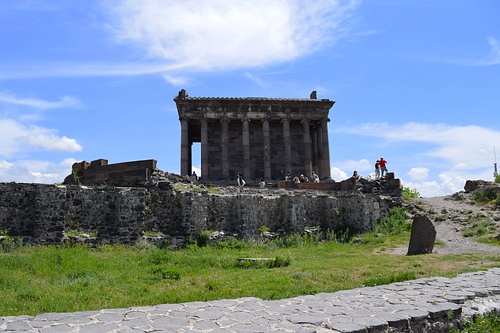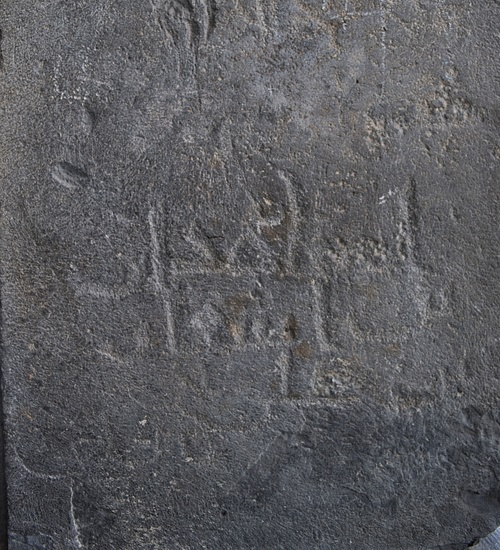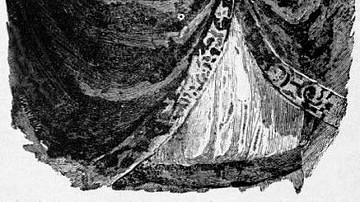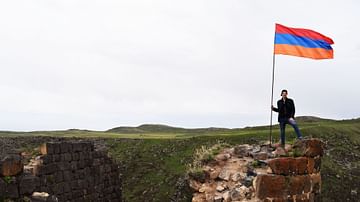
The Temple of Garni (Armenian: “Garnu tacar”) is located in the village of Garni in Kotayk Province, Armenia, and it was once a pagan temple dedicated to the Armenian sun god Mihr. Built in the middle of the 1st century CE, the Temple of Garni remarkably survived the destruction of pagan temples following Armenia's conversion to Christianity in the 4th century CE, and countless invasions and earthquakes until its collapse in 1679 CE. After continuous excavations in the late 19th and early 20th centuries CE, the Temple of Garni was reconstructed between 1969-1975 CE. Today, it is the only free-standing Greco-Roman structure in Armenia and seen by many as a potent symbol of Armenia's classical past as well as its deep historical ties to the civilizations of Greece and Rome.
History of the Temple
The Temple of Garni is situated in a very strategic location, on a cliff, overlooking a range of the Geghama mountains as well as the Azat River near the Ararat Plain. Located 30 km (19 mi) from Yerevan, the Temple of Garni is quite near Geghard Monastery, which is only 11 km (7 mi) up the Azat River, and not too far from the ancient capital of Artashat. The site was inhabited in prehistoric times, and there is evidence that it was also used by the Urartians between the 8th-6th centuries BCE.
Although the historical record concerning the Temple of Garni is limited, it seems probable that the temple was first constructed upon the orders of King Tiridates I of Armenia (r. 52-58 CE; 62-88 CE) sometime around 70-80 CE. This stands in contradiction to the opinion of the great Armenian historian Movses Khorenatsi who attributed the Temple of Garni's construction to Tiridates the Great (r. 287 CE - c. 330 CE) - Armenia's first Christian king - in the 3rd century CE. Other academics contend that it was not a temple but rather a former tomb to one of the pro-Roman kings of Armenia who lived in the 2nd century CE. This argument is sustained by the structural similarities between Garni and several mausolea in Asia Minor.
Tiridates I is primarily remembered in Armenian history for his visit to Naples and Rome in order to meet Emperor Nero (r. 54-68 CE) in 66 CE. The founder of the Arsacid dynasty of Armenia (52-428 CE), Tiridates I was a skilled diplomat, devout Zoroastrian, and lover of the arts. Although the Roman historian Tacitus claimed that Tiridates I was interested in all things Roman (Tacitus, Annals 15.5), it is more likely that Tiridates' exposure to and interest in Greco-Roman culture was deeply rooted given the fact that his mother was Greek and that he spoke Greek fluently. Curiously, Tacitus references the Temple of Garni, denoting it as the “Castellum Gorneae.”

A Greek inscription uncovered by Martiros Saryan in 1945 CE at the Temple of Garni suggests that Tiridates I was the patron and founder of Garni Temple, but there are many possible interpretations and readings of this inscription. One interpretation cited by Dr. Vrej Nersessian translates the inscription as the following:
The Sun God Tiridates, uncontested king of Great Armenia built the temple and the impregnable fortress in the eleventh year of his reign when Mennieay was hazarapet [thousander, chiliarch] and Amateay was sparapet [general, commander]. (103)
The area surrounding the Temple of Garni functioned as a royal garrison and military fortress in ancient and medieval times. It was later surrounded by Roman baths dating from the 4th century CE in addition to a four-apsed church and a single-naved church, which both date from the 7th century CE. There remains considerable academic debate as to whether Garni functioned as a summer palace as well in Late Antiquity. Researchers are in agreement that there was also an immense defensive wall constructed of monolithic stones rather than mortar, which was built perhaps in the 1st century BCE. Many khachkars (memorial stele with a cross) are located beside the Temple of Garni. An Urartian cuneiform stone relating the conquest of the area surrounding Garni and dating to the reign of Argishti I (r. 785-763 BCE) is also positioned close to the temple.
After Armenia became Christian in the early 4th century CE, the Temple of Garni was spared thanks to the intercession of Princess Khosrovdoukht who was the sister of Tiridates the Great. At the time, Tiridates led a concerted effort to systematically destroy all of Armenia's ancient pagan temples. Due to its strategic importance, the area around the Temple of Garni was subjected to multiple invasions by Romans, Persians, Arabs, Byzantines, Turks, and the Mongols. The temple itself was repeatedly violated, and today visitors can see Arabic graffiti, which dates from the 9th-10th centuries CE.

The Ottoman Turks raided the environs of Garni in 1638 CE during the Ottoman–Safavid War of 1623–39 CE, causing much destruction. Following a catastrophic earthquake in 1679 CE, the Temple of Garni collapsed and was left in ruins for hundreds of years. It was only in the late 19th century CE that archaeologists began to explore the site, and it was Nikoraios Mar who took the initiative to amass and safeguard the stones of the fallen temple between 1909-1911 CE in the hopes of one day resurrecting the temple. Alexander Sarhinyan oversaw the restoration of the Temple of Garni between 1969-1975 CE while Armenia was under the control of the Soviet Union.
Architecture
The Temple of Garni is the sole surviving pagan temple in Armenia and the only classical structure still standing in the country. Built on a podium, the temple is peripteral and oriented to the north. It is constructed of gray basalt that was quarried from the vicinity of Garni. The temple has 24 Ionic columns, which are 6.54 m (21.5 ft) high. Six are located in the front and the back parts of the temple, and eight on the sides. Some researchers believe that the columns originally came from Asia Minor and that they could symbolize the 24 hours of a day. The cella is about 7 m (23 ft) high, 8 m (26 ft) long, and 5 m (17 ft) wide. As it can only hold about 20-25 people inside, many historians and archaeologists believe it originally held a statue, perhaps of the sun god Mihr or Helios.

The equilibrium of elegant proportionality lends the Temple of Garni a concurrent impression of power and harmony. The temple is superbly decorated in the imperial Roman style. The architectural elements offer, however, certain variations that one recognizes in certain sculpted motifs, those representing lions in particular. The capitals themselves are singular; none are exactly identical with another. The friezes are dominated by acanthus leaves, which are sometimes mixed with laurels, oak leaves, and pomegranate trees.
The Roman baths found next to the Temple of Garni are built from brick and Armenian tuff (volcanic stone). They conform to the traditional layout found across the former Roman Empire and the Caucasus and are elegantly decorated with mosaics depicting mythological scenes.
This article was made possible with generous support from the National Association for Armenian Studies and Research and the Knights of Vartan Fund for Armenian Studies.







